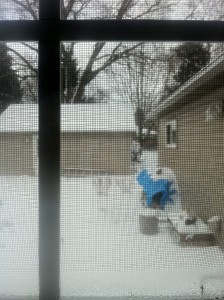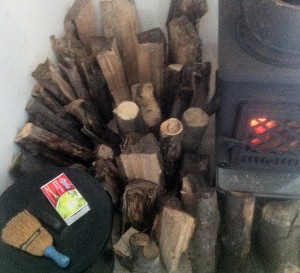A few years ago, when I made large sculpture out of Lego pieces, I typically dismantled works after they were shown so that I could reuse the bricks for new installations. There are a few things that I saved, including a blue pedestal and an irregularly shaped sculpture that people usually say looks like a chunk of dirty ice. Nowadays, it’s more like saving bits of ideas and groups of words that serve as springboards–think sour-dough starter–for new writing.
Since putting studio work on the back burner in favor of reading and writing, I’ve discovered all kinds of connections between making things out of Legos and making things out of words. And, since moving to Michigan and buying a wood-burning stove, I’ve discovered another kind of stacking, editing and consuming/recycling project–one that involves chunks of wood that my family, my neighbors and I gather.
Anyway, last night and today we’re having our first real snow of the winter–and we’re already in an awkward situation, wood-wise: we’ve already burned through the two small piles we so proudly sorted back in September. This leaves us contending with wood that, at best, is seasoned but wet and sits in two stacks in the back yard.
Not that we’re in trouble if the stove goes out, because we’ve got electric baseboard heat. But we really don’t want high heating bills this season, and we are doing our best to make our household more energy independent. So we’re all bundled up and there’s a good chance we’ve all been wearing the same clothes for at least the past 48 hours. Is that too much information?

This isn’t really a stump. It’s a cross-section of a small tree trunk. But I think of it as my stump.
Both yesterday and today, I’ve layered my vintage Husky jacket over my current ensemble, pulled boots on over the socks I’ve been wearing to bed, and gone outside to sort wood. If need be, my husband and I also have been cutting it shorter to fit into our sweet little Norwegian stove, or we’ve split it so that it burns more easily. Working in the cold, clean air feels great for about an hour. Then it’s time to head inside.
This process has produced a modest stack of small pieces of seasoned-but-wet wood, slowly drying out in the mudroom. Meanwhile, the stove is surrounded by other pieces of wood that are drying out more quickly thanks to, yes, the heat of the stove.
So we go outside and get cold, to collect fuel so that we can go back inside to be warm. If we weren’t using wood to stay warm, we wouldn’t have to go out and get cold. Plus, feeding the stove to dry out wood so that we can use it in the stove suggests some kind of vaguely ironic circularity, in which the warming of family is a collateral effect. But is it art?





